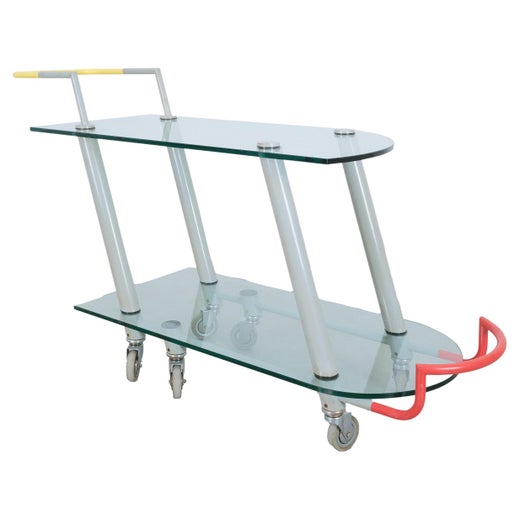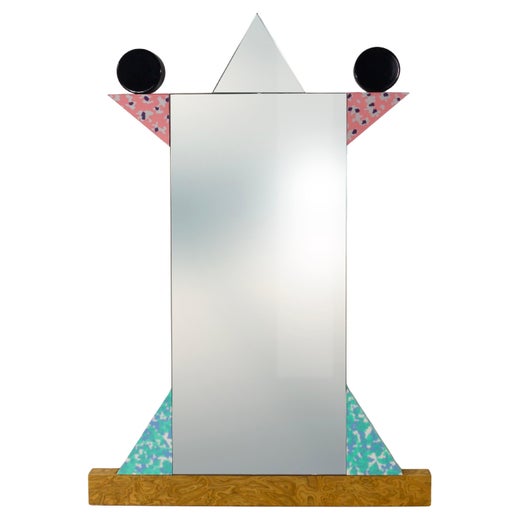1981, Javier Mariscal, Memphis Ed., Melamine and Lacquered Metal Serving Tray
About the Item
- Creator:Javier Mariscal (Designer),Memphis Group (Manufacturer)
- Dimensions:Height: 34.65 in (88 cm)Width: 31.5 in (80 cm)Depth: 16.93 in (43 cm)
- Style:Post-Modern (Of the Period)
- Materials and Techniques:
- Place of Origin:
- Period:1980-1989
- Date of Manufacture:1981
- Condition:Wear consistent with age and use.
- Seller Location:Paris, FR
- Reference Number:1stDibs: LU186735405403
Javier Mariscal
Javier Mariscal made a name for himself as a multidisciplinary creative — with such a fascinating range of projects under his belt, it would be difficult to confine him to labels such as artist, graphic designer or furniture maker.
While Mariscal integrates generous portions of plastics, polished chrome and other manmade materials into the creation of his furniture and decor, his work is stylish and forward-looking in a manner that dispenses with the institutional look of synthetic design. Vintage Javier Mariscal stools, lighting and tables are playful and lively, and are demonstrative of venturesome experimentation with form.
Born in Valencia, Spain, Mariscal attended the Elisava School in Barcelona in the 1970s to study design. He left school early, driven to learn from the world around him. His first major experience in real-world artistic pursuits was as an illustrator for a Spanish-language comic book in the mid-1970s. By 1979, Mariscal had shifted to product and furniture design. He created his distinctive chrome and leather Duplex stool that year, a piece that was manufactured by BD Barcelona Design for Bar Dúplex — a bar he co-owned and designed in his hometown.
Throughout the 1980s, Mariscal created some variations of the Duplex stool, developed furniture for iconic postmodern design collaborative the Memphis Group and made a foray into textiles. He created a range of rug designs that culminated in an exhibition at the Vinçon salon in Barcelona and led to collaborations with legendary textiles brand nanimarquina, which was established by designer Nani Marquina in 1987.
In 1989, the International Olympic Committee chose Mariscal's entry Cobi — a mountain dog designed in the Cubist style — as the official mascot of the 1992 Summer Olympics in Barcelona. To date, Cobi stands as one of the most recognizable Olympic mascots of all time.
Also in 1989, he opened his own studio — Estudio Mariscal. There he immersed himself in countless projects, collaborating with many notable names such as the famous Spanish architect Alfredo Arribas and Japanese architect Arata Isozaki. In 1999, the Spanish Department of Industry and the BCD Foundation recognized Mariscal for his many contributions to art across a wealth of industries.
Mariscal has since explored a variety of disciplines, from painting murals to drawing and co-directing for animated films including the 2010 feature-length animated movie Chico and Rita. He currently lives and works in Barcelona.
On 1stDibs, browse Javier Mariscal seating, rugs and tables.
Memphis Group
To many people, postmodern design is synonymous with the Memphis Group. This Italian collaborative created the most radical and attention-getting designs of the period, upending most of the accepted standards of how furniture should look.
The Memphis story begins in 1980, when Ettore Sottsass, then a beacon of Italian postmodernism, tapped a coterie of younger designers to develop a collection for the Milan Furniture Fair the next year, determined that all the new furniture they were then seeing was boring. Their mission: Boldly reject the stark minimalism of the 1970s and shatter the rules of form and function. (Sottsass’s Ultrafragola mirror, designed in 1970, embodied many of what would become the collective’s postmodern ideals.)
The group decided to design, produce and market their own collection, one that wouldn’t be restricted by concerns like functionality and so-called good taste. Its debut, at Milan’s 1981 Salone del Mobile, drew thousands of viewers and caused a major stir in design circles.
So as a record of Bob Dylan’s “Stuck Inside of Mobile” played on repeat, they took their name from the song, devised their marketing strategy and plotted the postmodern look that would come to define the decade of excess — primary colors, blown-up proportions, playful nods to Art Deco and Pop art. A high-low mix of materials also helped define Memphis, as evidenced by Javier Mariscal’s pastel serving trays, which feature laminate veneer — a material previously used only in kitchens — as well as Shiro Kuramata’s Nara and Kyoto tables made from colored glass-infused terrazzo.
An image of Sottsass posing with his collaborators in a conversation pit shaped like a boxing ring appeared in magazines all over the world, and Karl Lagerfield furnished his Monte Carlo penthouse entirely in Memphis furniture. Meanwhile, members like Andrea Branzi, Aldo Cibic, Michele de Lucchi, Nathalie du Pasquier, Kuramata, Paola Navone, Peter Shire, George Sowden, Sottsass and his wife, journalist Barbara Radice, went on to enjoy fruitful careers.
Some people think of the Milan-based collective as the design equivalent to Patrick Nagel’s kitschy screenprints, but for others Memphis represents what made the early 1980s so great: freedom of expression, dizzying patterns and off-the-wall colors.
Eventually, the Reagan era gave way to cool 1990s minimalism, and Memphis fell out of fashion. Sottsass left the group in 1985, and by 1987, it had disbanded. Yet decades later, Memphis is back and can be traced to today’s most exciting designers.
“As someone who was born in the 1980s, Memphis at times feels like the grown-up, artsy version of the toys I used to play with,” says Shaun Kasperbauer, cofounder of the Brooklyn studio Souda. “It feels a little nostalgic, but at the same time it seems like an aesthetic that’s perfectly suited to an internet age — loud, colorful and utilizing forms that are graphic and often a little unexpected.”
Find a collection of vintage Memphis Group seating, tables, decorative objects and other furniture on 1stDibs.
You May Also Like
21st Century and Contemporary Italian Modern Carts and Bar Carts
Metal
Vintage 1980s Italian Post-Modern Carts and Bar Carts
Steel
Vintage 1980s American Modern Carts and Bar Carts
Cut Glass
21st Century and Contemporary Italian Modern Tables
Metal
21st Century and Contemporary Italian Modern End Tables
Metal
21st Century and Contemporary Italian Modern Side Tables
Metal
Vintage 1950s American Mid-Century Modern Side Tables
Iron
Mid-20th Century Italian Mid-Century Modern Side Tables
Metal, Brass
Late 20th Century Post-Modern Side Tables
Laminate, Wood
Vintage 1980s Japanese Post-Modern Side Tables
Metal, Chrome

